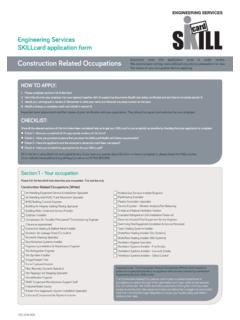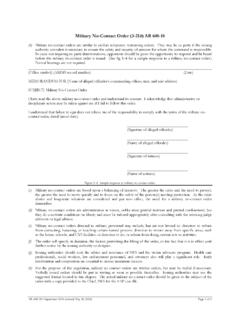Transcription of North American CRO Council
1 North American CRO Council Model Validation Principles Applied to Risk and Capital Models in the Insurance Industry 2012 No rt h A me rican CRO Council I nco rporated chairperso n@croco i Acknowledgement The CRO Council would like to thank Towers Watson for their support, guidance, and coordination throughout the development of this work product. ii Table of Contents Section 1 : Executive Summary ..1 Section 2 : Introduction ..3 Section 3 : Core Validation Principles ..4 Section 4 : 18 Section 5 : Literature Review and References .. 19 iii This page is intentionally blank 1 Section 1: Executive Summary With the progression of computer technology, model development and use has increased.
2 While models themselves have become mo re c omp le x, t he p urp ose of a model has rem ained t he s ame : to estimate reality in order to provide insight into posed questions. For e xample , in the co nte xt of insurance companies, models are ofte n used to estimate pote ntial financ ial o utco mes under alternative assumptions of the risks inherent in the business profile. Relying on models to inform decision-making exposes a company to model risk. Model risk refers to the risk that a model is not providing accurate output, that a model is b ei ng used i nappropr i ate l y, or that the implementation of an appropriate model is flawed.
3 During and after the financial crisis of 2008, models were perceived to be ineffective in producing sufficiently severe outcomes, which has put increased scrutiny on model risk management. While model risk management includes elements of model development and governance, model validation is a key are a of rese arc h that can help mitigate model risk, and its important role in model ris k management is the focus of this paper. Robust model validation can help provide internal and external stakeholders a level of confidence that a model framework is sound and that results, at some level, c an be relied upon to inform decisions. The primary purpose of model validation is ultimately to he lp address the management of model ris k.
4 By mitig ating model ris k, the persp ectives p rovided b y models should play a larger and more credible role in helping to s hap e co mp any strategies to ac hieve established objectives. The North American CRO Council is a professional association of Chief Risk Officers (CROs ) of leading insurers that seeks to promote key ris k ma nag e me nt p rin c ip le s , i nc luding that of model validation. Through the perspective gained from reviewing industry practices and the engagement of model validation practitioners both in North America and abroad, this paper strives to promote sound model validation practices. W hile the Co u n cil s intention is that these establis hed princ iples c an be applie d to any model, the d isc ussio n that follo ws will be foc used o n ris k and c apital mode ls in the insurance industry.
5 Such models are a core component in an enterprise risk management framework and are critical for enabling CROs and others to perform their duties. This paper is intended to be a useful guide in applying validation efforts to a particular model as well as in helping with the development of an overall company validation process. Key model validation principles laid out and addresse d in this paper are as follows: 1. Model design and build need to be consistent with the model s intended purpose 2. Ensure that model validation is an independent process 3. Establish an owner of model validation 2 4. Ensure appropriateness of established model governance 5.
6 Make model validation efforts proportional to evidenced areas of materiality and complexity 6. Validate the model components a. Input components b. Calculation components c. Output components 7. Address limitations of model validation 8. Document the model validation In summary, the p rimary focus of this paper is model valid atio n. In addition to initial validation of a new model, ongoing testing of model performance and revalidation are important aspects of model maintenance. Model governance-related issues are also touc hed upon, in particular thro ugh Princ iple 4, whic h addresses an effective framework with defined roles and responsibilities as well as the authority to restrict model use ( polic y and control-related activities ).
7 In general, distinct parties are respo nsible for these activities. Typically, comprehensive model ris k manage ment ado pted in the market includes the following elements: (i) mod el development, (ii) model validation, (iii) model governance and (iv) model use. A comprehensive approach to mode l risk management requires an effective approach to address each of these four elements. Again, the focus of this paper is limited to element (ii), model validation. 3 Section 2: Introduction By addressing aspects of model validation, the objective of this publication is to provide guidelines to interested stakeholders ( internal management, rating agencies, and regulators) on how to appro ach model valid atio n and to g auge the credib ility that can be assigned to a risk or capital model framework.
8 The general principles that follow are intended to be applicable to insurance company models and could help guide a company s internal procedures, policies and processes around model validation. It is important to keep in mind that resources used to add ress valid ation sho uld be kept p roportio nal to the materiality and reliance placed on the models used by the business. In the context of the principles, a model can be seen as a tool that uses pre-defined logic to arrive at potential financial assess me nts at vario us le vels of the o rganization d epe nd ing o n inputted ass umptions . W ith regards to the components of a model, thes e princ iples address inputs , the c alculation engines, and outputs.
9 While these principles can be applied to any model, this paper applies the principles with practical discussion and examples to risk and capital models. These models are used to assess ris k and the related capital ne e ds for both individual risks types as well as their aggregation ( an enterprise economic capital model). For example, categories of models that can be applied to the principles include: l Catastrophe Risk Models l Credit Risk Models l Insurance Risk Models ( underwriting, reserving, policyholder be havior, e tc .) l Market Risk Models l Capital Models ( aggregate ris k models) The principles are generally listed in sequential order such that a particular principle should be contemplated prior to addressing a subsequent one.
10 In general, the more robustly these princ iples are applie d, the g reater the c redibility that can be assig ned to a mode l s o utp ut. Given capital models in practice are typically aggregate risk models, unless otherwise stated, the applications of the principles discussed will refer generally to risk models. The ap p lic a tio ns of the principles to spec ific types of ris k models are thematically similar, except for Principle #6 which demonstrates how validation of the core model components can vary depending on the model type. 4 Section 3: Core Validation Principles A high level summary and reference chart of the core validation principles can be found below.




